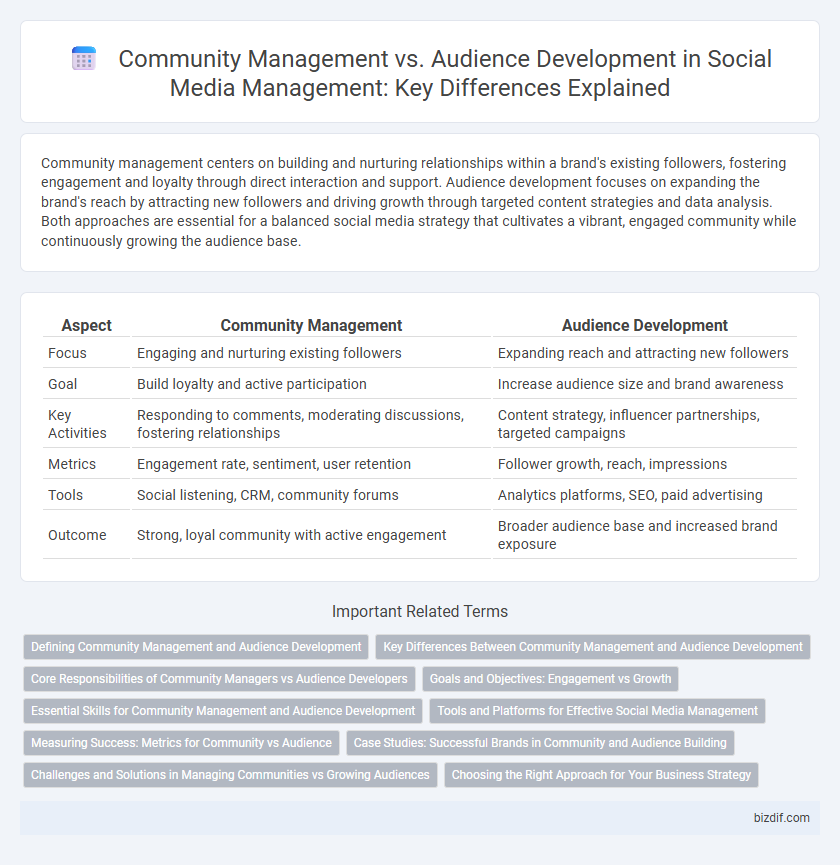Community management centers on building and nurturing relationships within a brand's existing followers, fostering engagement and loyalty through direct interaction and support. Audience development focuses on expanding the brand's reach by attracting new followers and driving growth through targeted content strategies and data analysis. Both approaches are essential for a balanced social media strategy that cultivates a vibrant, engaged community while continuously growing the audience base.
Table of Comparison
| Aspect | Community Management | Audience Development |
|---|---|---|
| Focus | Engaging and nurturing existing followers | Expanding reach and attracting new followers |
| Goal | Build loyalty and active participation | Increase audience size and brand awareness |
| Key Activities | Responding to comments, moderating discussions, fostering relationships | Content strategy, influencer partnerships, targeted campaigns |
| Metrics | Engagement rate, sentiment, user retention | Follower growth, reach, impressions |
| Tools | Social listening, CRM, community forums | Analytics platforms, SEO, paid advertising |
| Outcome | Strong, loyal community with active engagement | Broader audience base and increased brand exposure |
Defining Community Management and Audience Development
Community management involves actively engaging with followers, responding to comments, and fostering meaningful conversations to build a loyal and interactive user base. Audience development focuses on strategies to grow the social media following by targeting new demographics, optimizing content reach, and increasing brand visibility. Both practices are essential for sustaining long-term user engagement and expanding a brand's digital presence.
Key Differences Between Community Management and Audience Development
Community management centers on fostering engagement and nurturing relationships within a specific group by responding to comments, moderating discussions, and creating a sense of belonging. Audience development focuses on expanding reach by attracting new followers through targeted content strategies, analytics, and promotional campaigns. The key difference lies in community management's emphasis on deepening interaction with existing members, while audience development prioritizes growing the overall follower base and increasing brand visibility.
Core Responsibilities of Community Managers vs Audience Developers
Community managers focus on fostering meaningful interactions and maintaining healthy relationships within online groups by engaging members, moderating discussions, and addressing feedback promptly. Audience developers concentrate on expanding the reach and visibility of a brand through targeted campaigns, data analysis, and optimizing content to attract new followers and increase engagement metrics. Both roles are crucial, with community managers enhancing member retention and loyalty, while audience developers drive growth and brand awareness.
Goals and Objectives: Engagement vs Growth
Community management focuses on fostering meaningful interactions and increasing user engagement within existing social media groups by addressing feedback, encouraging conversations, and building brand loyalty. Audience development aims to expand the reach and attract new followers by analyzing demographics, optimizing content distribution, and leveraging targeting strategies to drive growth. Both strategies align with distinct goals: community management prioritizes deepening relationships, while audience development emphasizes increasing the number of active users.
Essential Skills for Community Management and Audience Development
Community management requires strong interpersonal skills, including active listening, conflict resolution, and empathy to foster genuine engagement and maintain a positive online environment. Audience development focuses on data analysis, content strategy, and trend identification to grow and target a relevant follower base effectively. Mastery of social media analytics tools and communication techniques is essential for both disciplines to optimize engagement and expand reach.
Tools and Platforms for Effective Social Media Management
Community management relies on engagement tools like Sprout Social and Hootsuite to monitor conversations and respond in real time, fostering strong interactions and loyalty. Audience development uses analytics platforms such as Google Analytics and Facebook Insights to identify growth opportunities, optimize content reach, and segment target demographics. Integrating both approaches with platforms like Buffer ensures cohesive strategy execution for enhanced social media presence.
Measuring Success: Metrics for Community vs Audience
Measuring success in community management relies heavily on engagement metrics such as response rate, sentiment analysis, and member retention, which reflect the strength and health of relationships within the community. Audience development focuses on growth metrics including follower count, reach, and conversion rates, emphasizing the expansion and influence of the brand's audience. Both approaches require tailored analytics tools to track qualitative community interactions versus quantitative audience growth effectively.
Case Studies: Successful Brands in Community and Audience Building
Case studies demonstrate that brands excelling in community management create engaged, loyal user groups through consistent interaction and personalized content on platforms like Facebook and Discord. Audience development strategies, as seen with companies like Glossier, focus on expanding reach via targeted campaigns on Instagram and TikTok, leveraging influencer partnerships and data-driven insights. Successful brands integrate both approaches, combining authentic community engagement with scalable audience growth tactics to maximize social media impact and brand loyalty.
Challenges and Solutions in Managing Communities vs Growing Audiences
Community management faces challenges like fostering genuine engagement and resolving conflicts among members, requiring solutions such as active moderation and personalized interactions. Audience development struggles with expanding reach and attracting new followers, often addressed through targeted content strategies and data-driven marketing campaigns. Balancing these efforts demands consistent analytics monitoring and adaptive communication approaches to maintain loyalty while scaling growth.
Choosing the Right Approach for Your Business Strategy
Community management centers on nurturing direct interactions and fostering loyalty within existing followers, enhancing brand trust through active engagement. Audience development emphasizes expanding reach by targeting new potential customers and increasing brand visibility through strategic content distribution and analytics. Selecting the right approach depends on business goals: prioritize community management for deeper customer relationships and retention, while audience development drives growth and attracts diverse market segments.
Community management vs Audience development Infographic

 bizdif.com
bizdif.com